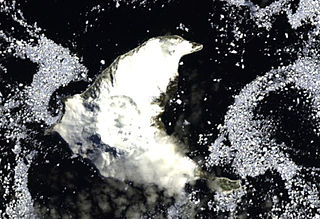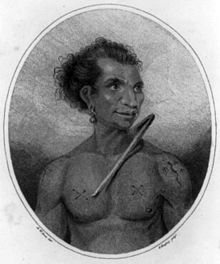
Koror is the state comprising the main commercial centre of the Republic of Palau. It consists of several islands, the most prominent being Koror Island. It is Palau’s most populous state.

The flag of Kiribati is red in the upper half with a gold frigatebird flying over a gold rising sun (otintaai), and the lower half is blue with three horizontal wavy white stripes to represent the ocean and the three archipelagoes. The 17 rays of the sun represent the 16 Gilbert Islands and Banaba.

The Challenger expedition of 1872–1876 was a scientific programme that made many discoveries to lay the foundation of oceanography. The expedition was named after the naval vessel that undertook the trip, HMS Challenger.

The Southern Hemisphere is the half (hemisphere) of Earth that is south of the Equator. It contains all or parts of five continents and four oceans, as well as New Zealand and most of the Pacific Islands in Oceania. Its surface is 80.9% water, compared with 60.7% water in the Northern Hemisphere, and it contains 32.7% of Earth's land.

Thule is the most northerly location mentioned in ancient Greek and Roman literature and cartography. First written of by the Greek explorer Pytheas of Massalia in about 320 BC, it was often described by later writers as an island north of the British Isles. Modern interpretations have included Orkney, Shetland, Northern Scotland, the Faroe Islands, or Iceland. Other potential locations are the island of Saaremaa (Ösel) in Estonia, or the Norwegian island of Smøla.

Foula, located in the Shetland archipelago of Scotland, is one of the United Kingdom's most remote permanently inhabited islands. The liner RMS Oceanic was wrecked on the Shaalds of Foula in 1914. Foula was the location for the film The Edge of the World (1937).

Thule Island, also called Morrell Island, is one of the southernmost of the South Sandwich Islands, part of the grouping known as Southern Thule. It is named, on account of its remote location, after the mythical land of Thule, said by ancient geographers to lie at the extreme end of the Earth. The alternative name Morrell Island is after Benjamin Morrell, an American explorer and whaling captain. The island was espied by James Cook and his Resolution crew on 31 January 1775 during his attempt to find Terra Australis.

Edinburgh of the Seven Seas is the only settlement on the island of Tristan da Cunha, a part of the British Overseas Territory of Saint Helena, Ascension and Tristan da Cunha in the South Atlantic Ocean. Locally, it is referred to as The Settlement or The Village.

Marske was a Thoroughbred racehorse, best known as siring the great Eclipse.

Henry Wilson (1740–1810) was an English naval captain of the British East India Company, from Rotherhithe. He was in command of the British East India Company packet ship Antelope, when it shipwrecked off Ulong Island, near Koror Island in Palau in 1783, and the East Indiaman Warley at the Battle of Pulo Aura.

Antelope was a packet ship built for the British East India Company (EIC) in 1781. She made one voyage for the company that ended when she was wrecked on 10 August 1783 off Ulong, near Koror Island in Palau. This resulted in the first sustained European contact with those islands.

Little Saint James is a small private island in the United States Virgin Islands, southeast of Saint Thomas. It was owned by American financier and sex offender Jeffrey Epstein from 1998 until his death in 2019. During Epstein's ownership, the island acquired the nickname Epstein Island.
Chinese have been settling in Palau in small numbers since the 19th century. The early settlers consisted of traders and labourers, and often intermarried with Palauan women. Their offspring quickly assimilated with the local populace and generally identify themselves as Palauan. In recent years, Palau has seen a growing expatriate business community from Taiwan, after Palau established formal diplomatic ties with Taiwan in 1999.

Prince Lee Boo or Lebu was the second son of Abba Thulle (Ibedul), the ruler of Koror in the Pelew Islands, now called Palau. Prince Lee Boo was one of the first people from the Pacific Islands to visit Great Britain. When the China trader Antelope, on a voyage to China for the East India Company, was wrecked on the island of Oroolong in Western Palau in 1783, its survivors, including Captain Henry Wilson, spent three months on Palau. When the survivors were finally rescued, Captain Wilson agreed to take Lee Boo to London to acquire more knowledge about Europe. He arrived about a decade after the Tahitian Omai, on 14 July 1784, in Portsmouth, aboard the Morse, and was quickly dubbed "The Black Prince" by London society, who were charmed by his poise and intelligence. The Wilson family took him into their home in London, where he attended church ceremonies, dinner parties and European school for several months. However, he died of smallpox on 27 December 1784, some six months after his arrival in London. He was 20 years old.

The Butterworth Squadron was a British commercial group of three vessels, Butterworth, Jackal, and Prince Lee Boo, that sailed for the Pacific Ocean from London via Cape Horn in late 1791. The principals financing the expedition were alderman William Curtis, London ship-owner Theophilus Pritzler, and probably John Perry, a Blackwall shipbuilder. The leader of the expedition was Captain William Brown, an established whaling captain from the Greenland whale fishery. Sigismund Bacstrom, a naturalist who had previously sailed as a secretary to Sir Joseph Banks, was the surgeon for the expedition. Bacstrom produced a number of drawings during the first part of the voyage, some of which are still in existence.
Butterworth was launched in 1778 in France as the highly successful 32-gun privateer Américaine, of Granville. The British Royal Navy captured her early in 1781. She first appeared in a commercial role in 1784 as America, and was renamed in 1785 as Butterworth. She served primarily as a whaler in the Greenland whale fisheries. New owners purchased her in 1789. She underwent a great repair in 1791 that increased her size by almost 20%. She is most famous for her role in the "Butterworth Squadron", which took her and two ship's tenders on an exploration, sealing, otter fur, and whaling voyage to Alaska and the Pacific Coast of North America. She and her consorts are widely credited with being the first European vessels to enter, in 1794, what is now Honolulu harbour. After her return to England in 1795, Butterworth went on three more whaling voyages to the South Pacific, then Africa, and then the South Pacific again. In 1802 she was outward bound on her fourth of these voyage, this to the South Pacific, when she was lost.

Yutaka Miller Gibbons was the ibedul of Koror from 1973 until his death in 2021. He was also an anti–nuclear weapons activist and political candidate.
Palau has several traditional chiefs of its 16 states. A factor that resulted in the decline of chiefly authority in Palau was the introduction of elected governors, called upon in the Constitution of Palau which came into effect on 1 January 1981.
The following lists events that happened during 2021 in the Republic of Palau.
John McCluer was a Scottish hydrographer who rose to the rank of captain in the Bombay Marine. Between 1785 and 1787 he surveyed Muscat and Matruh harbours at the entrance to the Gulf of Oman. In 1787 he was ordered to survey the bank of soundings off Bombay, which he did so thoroughly that his charts remained practically as he left them for nearly seventy years. In 1790 he was appointed to command a small expedition to the Pelew Islands, with the double object of surveying and establishing friendly relations with the natives. He was lost at sea in 1795.















